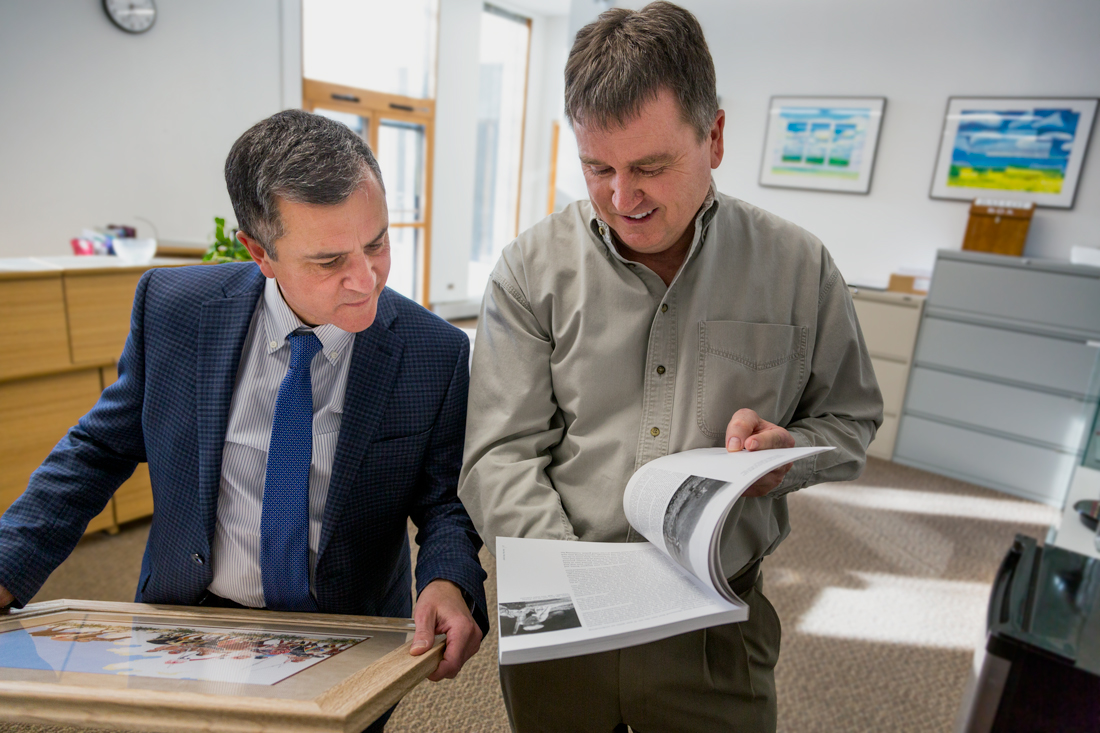
Prof. Gregory Bryan shows Education Dean David Mandzuk his book on Paul Goble and presents Mandzuk with a Goble painting to be housed in the Faculty of Education.
Telling a storyteller’s story
Prof. publishes book on world-renowned illustrator, author
Knowing time was short, author Gregory Bryan asked the printers to ship a copy of his book early so that the subject of the biography, failing in health, could review its pages.
Titled, “Paul Goble, Storyteller,” the account documents the life of the award-winning children’s author and illustrator, the product of four years of work. Although he sadly passed away two weeks before the book’s release, Prof. Bryan knew how Goble felt about the results of their labour.
“I am very happy that he received it before he passed away,” said Bryan, a children’s literature professor in the Faculty of Education. “His son told me that his last and largest smile was when the book arrived and he got to sit and look through it.”
As a children’s literature professor, Bryan first encountered Goble’s work as a student, and long identified him as his favourite illustrator.
“I was attracted—not just by the content of his stories and paintings, but by his very unique and special style.”
Spotting an opportunity eight years ago, Prof. Bryan went so far as to arrange to speak at a conference in Rapid City, S.D.—Goble’s hometown—because Bryan knew the illustrator would be attending. Upon meeting the author and illustrator, Bryan found Goble advanced in years and not in the best health.
“It occurred to me—not only that his biography had not been written but that it should be written.” Cautiously, Goble agreed.
An Englishman who moved to South Dakota in 1977, Goble carved out a storied career, illustrating more than 40 books—particularly of Indigenous stories and culture—during his lifetime, winning both the Caldecott Medal and The Library of Congress’ Children’s Book of the Year Award. But perhaps Goble’s greatest contribution was his influence on promoting South Dakota’s Indigenous culture. In 1969, when Goble published his first book, “Red Hawk’s Account of Custer’s Last Battle,” few children’s books were being written about Indigenous stories. Since then, Bryan says many Indigenous artists and writers he interviewed claim that native Americans are now the primary beneficiaries of Goble’s work. For example Kevin Locke, a world-renowned Lakota hoop-dancer “… In a letter to Paul, he said that he couldn’t think of anybody who had done more for his culture than Paul Goble,” Bryan said, adding he felt very strongly that Goble had greatly contributed to the renaissance in Lakota art and culture.
Unfortunately for Bryan’s work as a biographer, Goble was humble to a fault, apparently unaware of the significance of his work and contributions.
“(Humility) was part of the Paul Goble charm, and it presented some challenges,” Bryan says. However, as their relationship grew, so did a mutual trust, and as a result, the biographer was granted access other researchers were not.
“The day his wife said to me that it feels like I have become part of the home, I took that as a wonderful compliment.”
In reviewing personal scrapbooks, notebooks, journals, and family photo albums, Bryan gained a fulsome understanding of the artist’s process, and included notes, family photos and sketches in the pages of “Storyteller”.
Throughout the process, Goble reviewed drafts, filled story gaps where necessary and corrected errors.
“One of the things he did say throughout the process was: Greg, nobody is going to be interested in this.”
Bryan was convinced otherwise, and the book’s reception has proved him right.
Crowds flocked to the book launch, held at the South Dakota Art Museum in Brookings, where some 500 of Goble’s paintings are housed, donated by the artist to the museum. Presentations, book-signings, radio and other media followed in Rapid City and elsewhere in South Dakota, and Bryan hopes to generate more interest with a travelling exhibit of 30 of the artist’s works called “A Life’s Work” that will be housed in in Rapid City until April when it moves to Pierre, S.D., until September. Bryan, who helped to organize the tour, hopes to bring it to Winnipeg and other locations in Canada.
“The book and tour have only just been launched but they’re doing very well,” he said.
“In our age of reconciliation, I think there is a desire in education to include more Indigenous content in classrooms, and in fact, in everyday life,” he said, adding the book provides Indigenous perspectives that could be used in Manitoba classrooms. “Regardless of where we are, Paul’s love of nature is also something we should be embracing.”







Nice work Professor Bryan! I look forward to reading the biography and checking out Mr. Goble’s books as well.
Sincerely your old student Pam 🙂
Congratulations Greg! I can’t wait to read it. I’m so glad Mr. Goble was able to see it before he passed. I’m sure it will be treasured by his wife.
Take care,
Angie